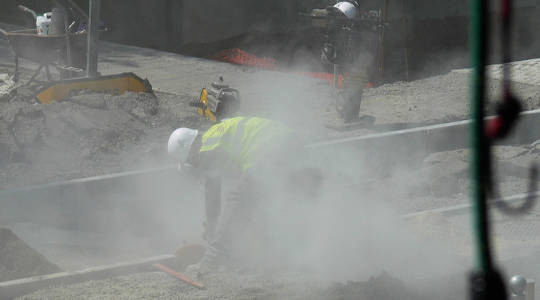
You can barely see this construction worker for dust. His lack of protective face mask puts him at risk of silicosis and other lung diseases. Lamiot/Wikimedia, CC BY-SA
Silicosis is a group of occupational lung diseases caused by breathing in silica dust. It has been described since ancient times, when miners and stone cutters were exposed to dust containing this crystalline mineral.
Silicosis was more common in Australia in the 1940s to 60s, particularly in construction and demolition workers. Growing awareness of the disease and the importance of reducing exposure to dust – for instance, wearing masks at work, wetting the dust and other safe work practices – has reduced the number of cases.
However, there has been a worrying resurgence of cases recently, as a recent New South Wales parliamentary committee has heard. Now one of the fastest growing occupational groups we’re seeing with silicosis are people who make and install engineered stone products, the type of benchtops and tiles you might find in your kitchen or bathroom.
This resurgence in cases is likely related to a poor understanding of the risks involved in working with engineered stone, and a lack of adherence to safety regulations and surveillance requirements.
What is silica and how are people exposed?
Silica is in quartz, sand, stone, soil, granite, brick, cement, grout, mortar, bitumen and engineered stone products.
Any occupation disturbing the earth’s crust increases the risk of silicosis. That includes sand blasting, cutting, excavating, building on sandstone, demolition work, tunnelling, quarry work and mining. Air-polishing concrete, foundry work, bricklaying, stone masonry, and making glass and ceramics also increase the risk.
About 6.6% of Australian workers are exposed to crystalline silica dust that can be breathed in, and 3.7% are heavily exposed.
While not all of these will go on to develop silicosis a significant proportion will, with symptoms appearing between months and many years after exposure, depending on the type of silicosis.
The likelihood of developing severe silicosis increases depending on how much dust people are exposed to and for how long. Genetics may also play a role in susceptibility, with some groups, like African Americans, having a higher risk.
Symptoms of silicosis include a cough, breathlessness and tiredness. But in the early stages of the disease, there may be no symptoms.
As silicosis can progress long after exposure at work, people should report any troublesome symptoms to their GP, even after they have left the industry. If silicosis is suspected, they should be referred to a respiratory physician.
Different types of silicosis
There are three different types of silicosis :
* acute silicosis can develop within weeks of very heavy exposure to silica. The lungs are filled with a fluid containing a lot of protein, which causes severe breathlessness
* accelerated silicosis is also associated with high exposures (the type currently being seen in people working with engineered stone products), where
* chronic silicosis, the most common form of silicosis, where fibrosis occurs more slowly over 10-30 years after first being exposed.
Then there’s simple and complicated silicosis. Simple silicosis results in many small white spots (nodules) that you can see on a chest x-ray or CT scan. With complicated silicosis there are large areas of scarring called progressive massive fibrosis.
In general, the more scarring and the more widespread it is, the more trouble people have breathing as their lungs lose their capacity to expand and contract with each breath. Silicosis also increases people’s susceptibility to tuberculosis.
How is silicosis treated and what are the outcomes?
Diseases due to silica exposure are serious and potentially lethal, and there is no specific treatment other than supportive care. This can include stopping smoking, using inhalers, vaccination against infections, and antibiotics. In the late stages, oxygen treatment or a lung transplant may be needed.
Once diagnosed, the disease generally progresses over time. Patients with accelerated silicosis may progress to progressive massive fibrosis over a period of four to five years. Overall, people diagnosed with silicosis lose an average 11.6 years of life. So, prevention is vital.
How can we prevent silicosis?
Diseases due to silica exposure – for instance silicosis, lung cancer, connective tissue disorders like scleroderma, kidney disease and chronic obstructive lung disease – are entirely preventable.
Wetting of silica dust, using appropriate exhaust ventilation and extraction hoods, and wearing the right dust masks and air filters all reduce the chances of someone breathing in silica dust at work.
There are also workplace standards on exposure to silica dust. And workplace screening for lung disease is mandatory for those at significant risk, which can include a physical examination as well as x-rays and lung function tests.
How can we keep track of silicosis?
Silicosis carries a high social and economic cost. And workers can receive compensation for silica-related disease in some states. In NSW, for instance, 186 workers received compensation payments through the Dust Diseases Board in 2002-2003.
Yet, we don’t know the true number of new cases in Australia. While there are voluntary reporting systems in Victoria, Tasmania and NSW, these are likely to have underestimated the true incidence of disease.
So specialist doctors concerned about the resurgence of silicosis have called for mandatory reporting of occupational lung disease to a centralised registry, as occurs in Europe and America.
![]() Australia is seeing the re-emergence of diseases like silicosis and coal worker’s lung (also known as black lung) that were previously believed to have disappeared. So, workers, employers, doctors, public health officials, and legislators need to work together to prevent more cases of these deadly, but preventable, lung diseases.
Australia is seeing the re-emergence of diseases like silicosis and coal worker’s lung (also known as black lung) that were previously believed to have disappeared. So, workers, employers, doctors, public health officials, and legislators need to work together to prevent more cases of these deadly, but preventable, lung diseases.
About The Author
Susan Miles, Respiratory, sleep and general physician and conjoint lecturer in medicine, University of Newcastle
This article was originally published on The Conversation. Read the original article.
Related Books:
at InnerSelf Market and Amazon























